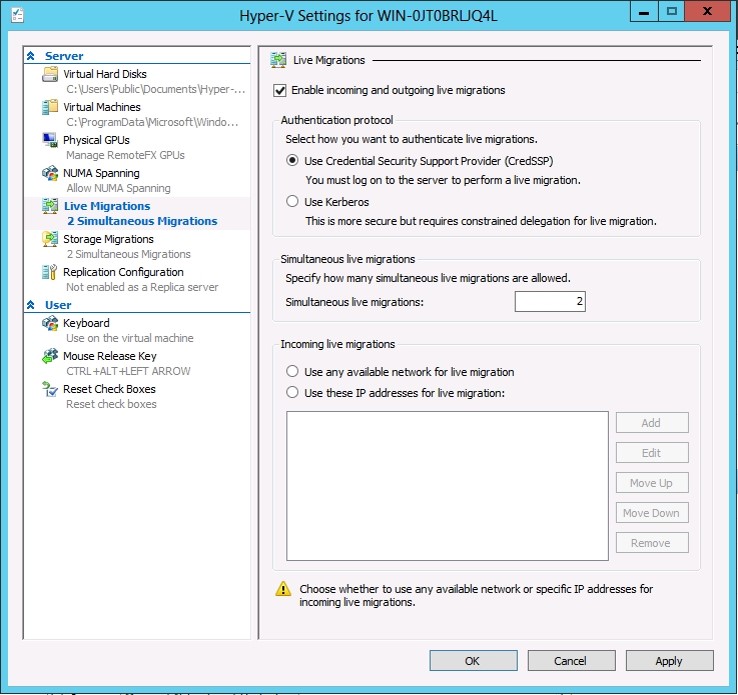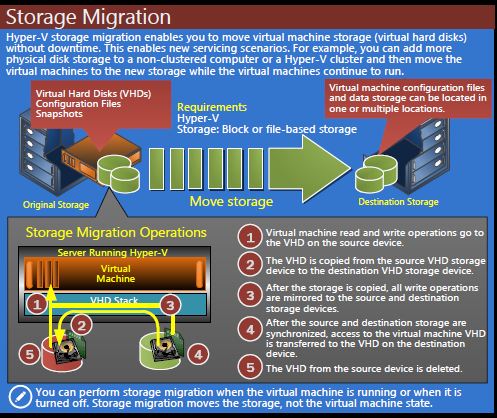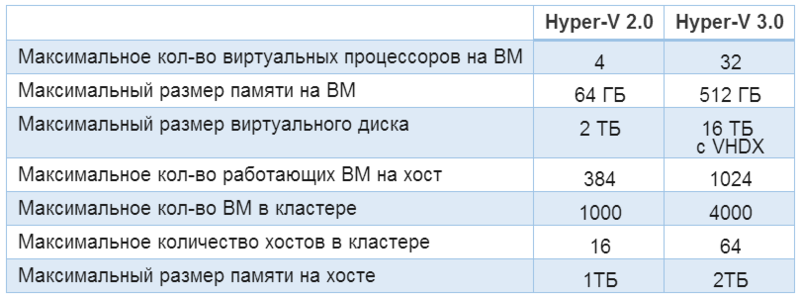Microsoft Hyper-V 3.0: New Features
With the release of Windows Server 2012, the virtualization system, Hyper-V, has also been updated. This article discusses what new features have appeared in Hyper-V 3.0. It should be noted that the third version contains a lot of improvements in functionality compared with the previous version, and, most importantly, for the first time in the history of Hyper-V, Microsoft's virtualization system has reached the level of Enterprise-level products comparable to VMware vSphere 5.
The main tool for managing and monitoring Hyper-V is the Hyper-V Manager (see figure). Starting with version 3.0, many new management features have become available through PowerShell. For example, you can start the VM1 virtual machine using the “Start -VM vm1” command. Further, the key features of the new version of Hyper-V will be discussed.

The memory allocation technique in such a way that the total amount of memory allocated to individual virtual machines of the virtualization server exceeds the amount of memory generally available on this virtualization server is called Memory Overcomitment , and its development in Hyper-V 3.0 is Memory Ballooning . These technologies allow to increase the server consolidation ratio through increasing the density of virtual machines (the number of virtual machines per virtualization server). This result is achieved due to the dynamic redistribution of memory allocated to individual virtual machines, taking into account the activity of the virtual machine, its status (on, off), parameters such as "minimum memory" and "memory size at the start of the virtual machine" (they can define administrator). Moreover, if in Hyper-V 2.0 these two parameters were actually equivalent, then in Hyper-V 3.0 they are completely independent, for example, for the start phase of the machine, you can allocate more memory than the minimum that the virtual machine will receive in the work phase, but a period of inactivity.
')
Live Migration (virtual machine migration between virtualization servers without having to shut them down) appeared in Hyper-V 2.0. Initially, there was a limitation - you could only move one virtual machine of a virtualization server at a time. In Hyper-V 3.0, this restriction is removed - several virtual machines can be migrated in parallel, while the administrator can set a limit on the number of simultaneously moved virtual machines to avoid network overload.

Previously, the migration of virtual machines within Live Migration was possible only within the cluster nodes. In Hyper-V 3.0, this restriction no longer exists. This “trans-cluster” movement of a virtual machine is called Shared Nothing Live Migrations . It should be noted that this feature should not be viewed as a long-term replacement for traditional clusters, and should be used primarily only for actually moving virtual machines to the required virtualization server.
Requirements for Shared Nothing Live Migration :
This technology differs from Live Migration in that the virtual machine files are moved from one storage to another, despite the fact that the virtual machine itself continues to run on the same virtualization server. This technology has replaced the technology of Quick Storage Migration, available in Hyper-V 2.0. In Hyper-V 3.0, the virtual machine’s storage migration occurs without shutting down or pausing its work (unlike the previous version of Hyper-V).

This technology allows you to replicate a running virtual machine to another virtualization server. Incremental changes are transferred according to a custom schedule with a minimum start interval close to real time in terms of backup (“Near CDP”) - approximately 5-15 minutes. Hyper-V Replica can work on lines with high time delays and unstable communications. This technology is positioned by Microsoft as a means of protection against catastrophic failures.

The accumulation of snapshots in the system leads to a decrease in performance. In this connection, an important improvement in Hyper-V 3.0 was the ability to remove unnecessary snapshots without restarting the virtual machine (this was required in Hyper-V 2.0).
In Hyper-V 3.0, you can add disk resources and RAM without restarting the virtual machine. The ability to hot-add virtual processors, which VMware vSphere has, is not yet implemented in Hyper-V.
Since Hyper-V is part of Windows Server 2012, deduplication at the file system level appeared in the new version of the automatic virtualization environment. Deduplication reduces disk space consumed by VHD libraries, VHD volumes, and ISO images of disks by eliminating duplicate data blocks stored on disks.
In Hyper-V, 3.0 virtual switch has become extensible, allowing software manufacturers to monitor and manage network infrastructure to create expansion modules for integrating Hyper-V virtual switch with their products.
The Hyper-V 3.0 version contains many improvements and new features that, in general, make it possible to argue that this version will be able to compete with VMware vSphere in the corporate segment.
PS Posters Source: Microsoft Tech Net.
The main tool for managing and monitoring Hyper-V is the Hyper-V Manager (see figure). Starting with version 3.0, many new management features have become available through PowerShell. For example, you can start the VM1 virtual machine using the “Start -VM vm1” command. Further, the key features of the new version of Hyper-V will be discussed.

Memory ballooning
The memory allocation technique in such a way that the total amount of memory allocated to individual virtual machines of the virtualization server exceeds the amount of memory generally available on this virtualization server is called Memory Overcomitment , and its development in Hyper-V 3.0 is Memory Ballooning . These technologies allow to increase the server consolidation ratio through increasing the density of virtual machines (the number of virtual machines per virtualization server). This result is achieved due to the dynamic redistribution of memory allocated to individual virtual machines, taking into account the activity of the virtual machine, its status (on, off), parameters such as "minimum memory" and "memory size at the start of the virtual machine" (they can define administrator). Moreover, if in Hyper-V 2.0 these two parameters were actually equivalent, then in Hyper-V 3.0 they are completely independent, for example, for the start phase of the machine, you can allocate more memory than the minimum that the virtual machine will receive in the work phase, but a period of inactivity.
')
Live migrations
Live Migration (virtual machine migration between virtualization servers without having to shut them down) appeared in Hyper-V 2.0. Initially, there was a limitation - you could only move one virtual machine of a virtualization server at a time. In Hyper-V 3.0, this restriction is removed - several virtual machines can be migrated in parallel, while the administrator can set a limit on the number of simultaneously moved virtual machines to avoid network overload.

Previously, the migration of virtual machines within Live Migration was possible only within the cluster nodes. In Hyper-V 3.0, this restriction no longer exists. This “trans-cluster” movement of a virtual machine is called Shared Nothing Live Migrations . It should be noted that this feature should not be viewed as a long-term replacement for traditional clusters, and should be used primarily only for actually moving virtual machines to the required virtualization server.
Requirements for Shared Nothing Live Migration :
- At least two virtualization servers Hyper-V 3.0
- Servers must be included in the same Active Directory domain.
- To ensure maximum server performance, you must have processors with the same architecture (see the description of compatible processors in the Hyper-V 3.0 documentation)
- Servers must be connected by a gigabit or faster network connection.
- Virtual switches must have the same configuration.
- Client for Microsoft Networks and File and Print Sharing for Microsoft Networks should be included.
Storage migration
This technology differs from Live Migration in that the virtual machine files are moved from one storage to another, despite the fact that the virtual machine itself continues to run on the same virtualization server. This technology has replaced the technology of Quick Storage Migration, available in Hyper-V 2.0. In Hyper-V 3.0, the virtual machine’s storage migration occurs without shutting down or pausing its work (unlike the previous version of Hyper-V).

Replication (Hyper-V Replica)
This technology allows you to replicate a running virtual machine to another virtualization server. Incremental changes are transferred according to a custom schedule with a minimum start interval close to real time in terms of backup (“Near CDP”) - approximately 5-15 minutes. Hyper-V Replica can work on lines with high time delays and unstable communications. This technology is positioned by Microsoft as a means of protection against catastrophic failures.
Scalability

Snapshots
The accumulation of snapshots in the system leads to a decrease in performance. In this connection, an important improvement in Hyper-V 3.0 was the ability to remove unnecessary snapshots without restarting the virtual machine (this was required in Hyper-V 2.0).
Hot Add Resources
In Hyper-V 3.0, you can add disk resources and RAM without restarting the virtual machine. The ability to hot-add virtual processors, which VMware vSphere has, is not yet implemented in Hyper-V.
Deduplication
Since Hyper-V is part of Windows Server 2012, deduplication at the file system level appeared in the new version of the automatic virtualization environment. Deduplication reduces disk space consumed by VHD libraries, VHD volumes, and ISO images of disks by eliminating duplicate data blocks stored on disks.
Virtual switch
In Hyper-V, 3.0 virtual switch has become extensible, allowing software manufacturers to monitor and manage network infrastructure to create expansion modules for integrating Hyper-V virtual switch with their products.
Findings:
The Hyper-V 3.0 version contains many improvements and new features that, in general, make it possible to argue that this version will be able to compete with VMware vSphere in the corporate segment.
PS Posters Source: Microsoft Tech Net.
Source: https://habr.com/ru/post/159339/
All Articles